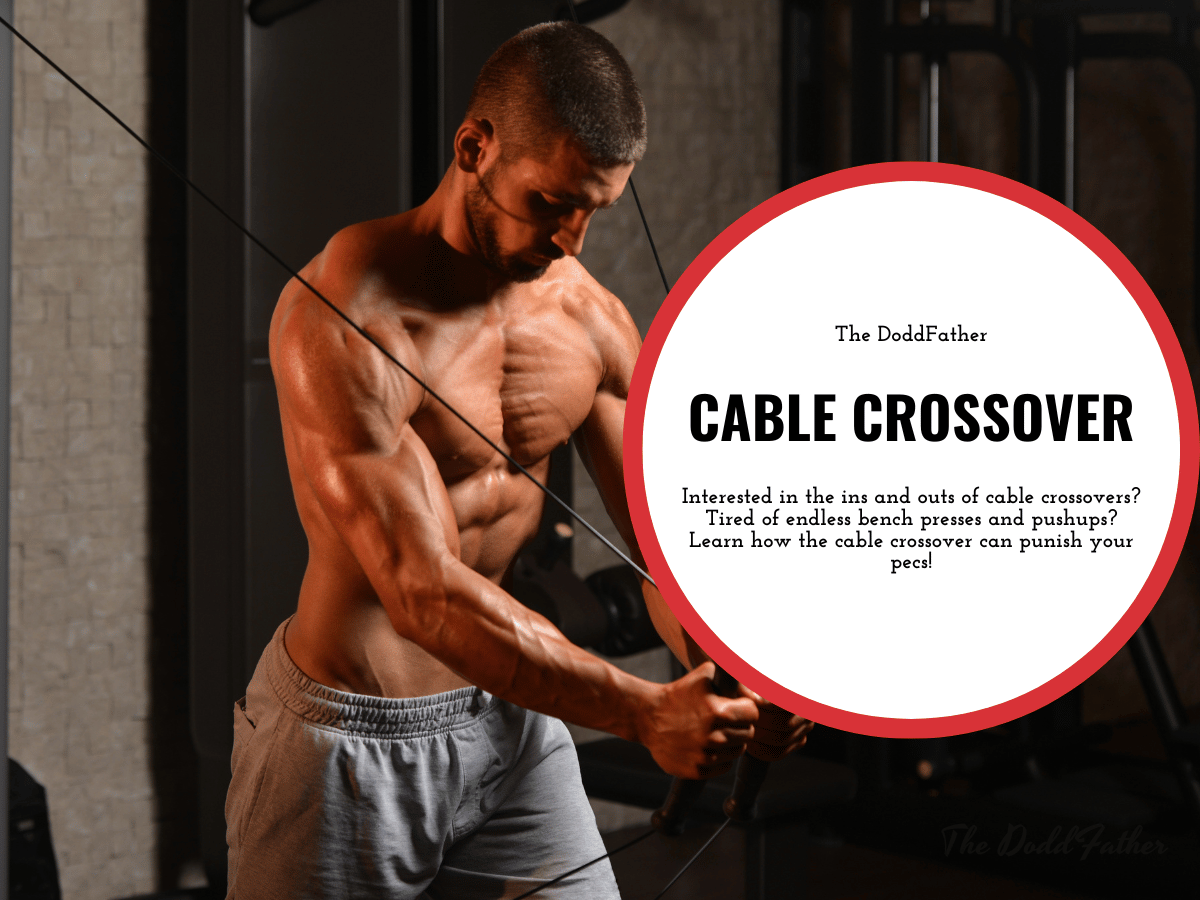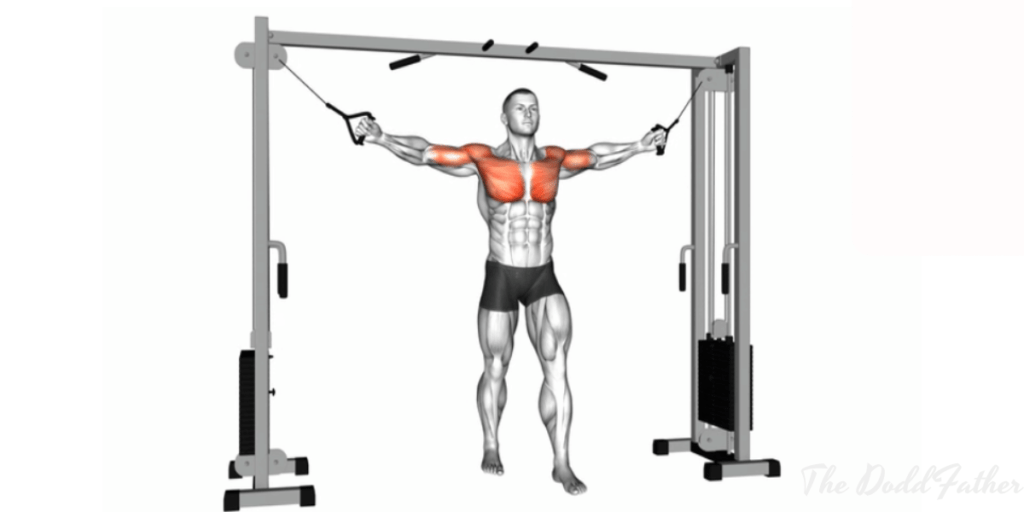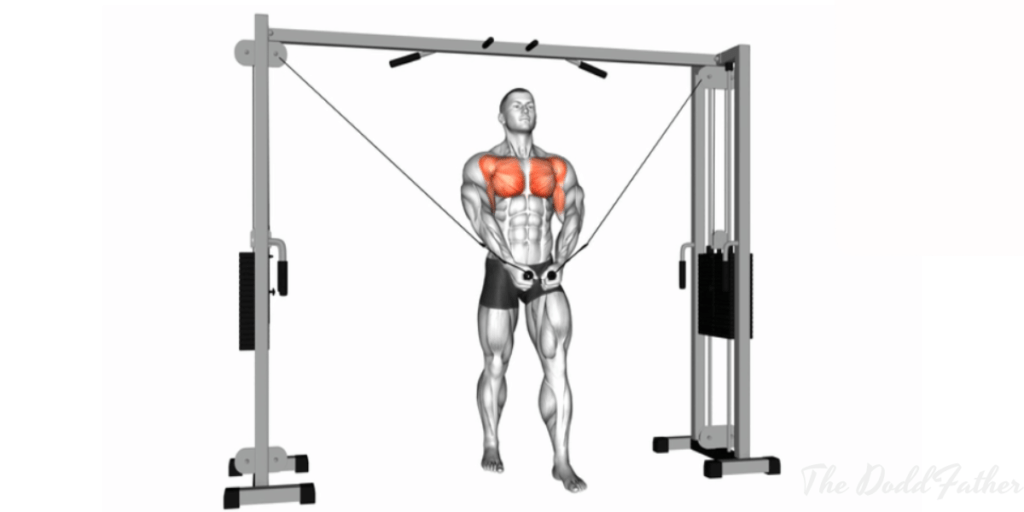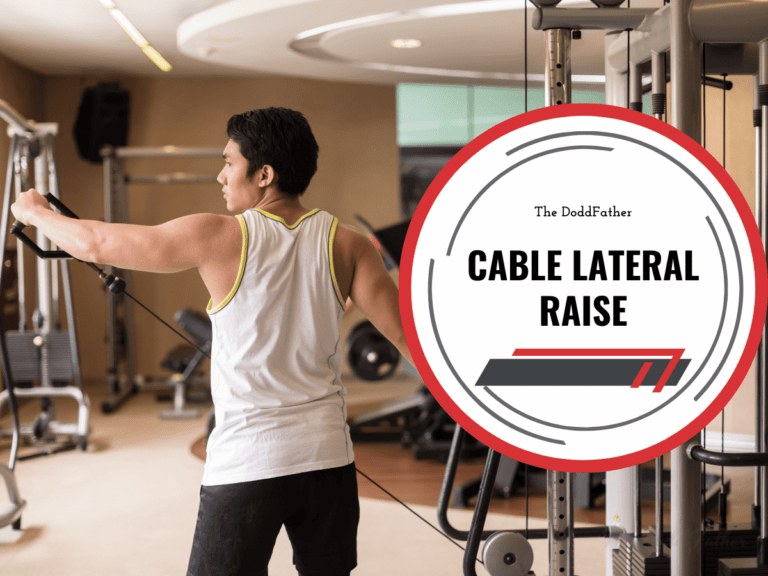
Cody Dodd is a NASM-certified personal trainer and Navy Command Fitness Leader who uses his fitness expertise to write fitness content for The DoddFather. Cody has transformed his physique and confidence by understanding the principles of exercise and fitness.
It all started with a radical fat loss of 55 pounds. From 225 to 170. From a kid who once couldn’t do a pull up, to knocking out 20 pullups in a Navy command competition while floating in the middle of the ocean.
He has a diverse writing and editing background that’s primarily focused on health and fitness, Navy life, and dad life. His work has been featured in Good Dads, as well as Platform Launchers, and Daddying.
Ever walked into the gym, spotted those intimidating cable machines, and thought, “What in the world do I do with these?” Well, you’re in for a treat!
Today, we’re diving into the world of cable crossovers – a game-changer for your chest workouts. You know, I used to think that building a strong, defined chest meant endless bench presses and push-ups. And there IS merit to that.
But part of staying in the weightlifting game is having fun and trying new things. Adding cable crossovers to your routine could be the variety you need! It’s all about understanding the exercise and making it work for you. So, let’s get into it and unlock the potential of this awesome move!
What is a Cable Crossover, Anyway?
So, picture this – you’re in the gym, surrounded by all sorts of machines, and you spot this contraption with two towering cables stretching across. That, my friend, is a cable crossover machine. It might look intimidating at first, but there’s no need to fear.
At its core, the cable crossover is an isolation exercise that primarily targets your pectoralis major – the big fan-shaped muscle that makes up the bulk of your chest. But it doesn’t stop there. It also engages your anterior deltoids (the front of your shoulders) and triceps, giving you a well-rounded upper body workout.
Now, you might be wondering, “Why bother with cable crossovers when I can just bench press my way to glory?” Well, let me tell you, there’s something special about this exercise.
It allows for a greater range of motion compared to traditional chest exercises, leading to better muscle activation and growth. Plus, the constant tension provided by the cables keeps your muscles engaged throughout the entire movement, maximizing those gains. I found that high volume works best for me on this movement. I’ll do something like 3-4 sets of 15-20 reps.
Setting Up for Success: Proper Form and Technique
Alright, now that you know what a cable crossover is, let’s talk about how to actually do it. There’s no denying that proper form is everything. You can have the fanciest machine in the world, but if you’re doing it wrong, you’re not only wasting your time, but also risking injury.
Step-by-Step Guide:
- Cable Adjustment: First things first, adjust those cables to a high position. We’re aiming for roughly shoulder height or slightly above.
- Weight Selection: Don’t go too heavy, especially when you’re starting out. It’s better to master the form with a lighter weight and gradually increase it as you get stronger.
- Stance: Stand in the middle of the machine with your feet shoulder-width apart, knees slightly bent, and core engaged.
- Grip: Grab the handles with a neutral grip (palms facing each other) and take a small step forward, creating tension in the cables.
- The Movement: Now, here’s the magic. Keeping a slight bend in your elbows, slowly bring your hands together in front of your chest, focusing on squeezing your chest muscles.
- Controlled Return: Resist the urge to let the cables pull your arms back. Slowly return to the starting position, maintaining tension in the cables.
Common Mistakes (and How to Avoid Them):
- Rounding your back: This puts unnecessary strain on your spine. Keep that back straight and chest up throughout the movement.
- Using momentum: Don’t swing your arms or use your body weight to move the cables. It’s all about controlled muscle contractions.
- Crossing your arms too far: Stop when your hands are in line with your chest. Going further puts stress on your shoulder joints.
- Locking your elbows: Keep a slight bend in your elbows to protect your joints and maintain tension in the muscles.
Tips for Maintaining Proper Form:
- Engage your core: Think of it as bracing your entire body for the movement.
- Focus on the squeeze: Really feel those chest muscles contracting as you bring your hands together. Imagine trying to crack an egg between your pecs at the peak of the movement.
- Breathe: Don’t hold your breath. Inhale as you open your arms and exhale as you bring them together.
- Use a mirror: Check your form in the mirror or have a friend watch you. It’s amazing how many little tweaks you can make just by seeing yourself in action.
I remember when I first started doing cable crossovers, I was all over the place. My back was rounding, my arms were swinging, it was a mess. But I kept practicing, focusing on the cues my trainer gave me, and eventually, it clicked.
So, don’t get discouraged if it feels awkward at first. Stick with it, pay attention to your form, and you’ll be reaping the benefits in no time.
Rule of thumb, if you’re not feeling muscle activation in the primary muscle that a move is targeting, something needs to be tweaked. To be frank, everyone responds to movements differently. What fires my chest up might not do it for you, and vice versa.
Cable Crossover Variations to Spice Up Your Chest Day
Doing the same exercise over and over can get a bit monotonous. But fear not, because the cable crossover machine is more versatile than you might think. By tweaking the angles and positions, you can target different areas of your chest and keep those gains coming.
High to Low Cable Crossover
This variation emphasizes the lower portion of your chest. Instead of starting with the cables at shoulder height, adjust them to a high position. As you bring your hands together, aim for a point slightly below your chest. You’ll feel that lower chest burn like never before.
Low to High Cable Crossover
Flip the script and target your upper chest with this variation. Set the cables to a low position and bring your hands together in an upward arc, aiming for a point slightly above your chest. It’s like giving your upper pecs a high-five!
Single-Arm Cable Crossover
Want to focus on one side at a time? Try the single-arm cable crossover. It’s a great way to correct any muscle imbalances and ensure both sides of your chest are getting equal attention. Plus, it challenges your core even more as you stabilize your body during the movement.
Kneeling Cable Crossover
This one’s a bit more advanced, but it’s a killer for intensifying the chest contraction. Kneel down in the middle of the machine and perform the crossover motion. You’ll be amazed at how much harder it is to control the cables when you’re in a kneeling position.
These are just a few ideas to get you started. Don’t be afraid to experiment and find what works best for you. Maybe you’ll discover a whole new variation that becomes your go-to chest exercise!
Programming Cable Crossovers into Your Workout
Now that you’re a cable crossover pro, let’s talk about how to fit it into your overall workout routine. After all, it’s not just about doing the exercise, it’s about doing it strategically to maximize those gains.
Recommended Sets and Repetitions
Generally, I’d recommend aiming for 3-4 sets of 10-15 repetitions per set. This strikes a good balance between building muscle and improving muscular endurance. But remember, everyone’s different. If you’re new to cable crossovers, start with fewer sets and reps and gradually increase as you get stronger.
How to Progress and Increase Difficulty Over Time
Don’t get stuck in a rut doing the same weight and reps every workout. Here are a few ways to challenge yourself and keep those gains coming:
- Increase the weight: This one’s pretty straightforward. As you get stronger, add a little weight to the cables.
- Increase the reps: If you’re consistently hitting 15 reps with good form, try bumping it up to 18 or 20.
- Slow down the tempo: Instead of rushing through the movement, try slowing it down. This increases the time your muscles are under tension, leading to greater growth.
- Add a pause at the peak contraction: Hold the squeeze at the bottom of the movement for a second or two before returning to the starting position.
- Try drop sets: Perform a set to failure, then immediately reduce the weight and do another set to failure. This is a great way to push your muscles to their limits.
Incorporating Cable Crossovers with Other Chest Exercises
Cable crossovers are a fantastic isolation exercise, but don’t forget to include compound movements like bench press, incline dumbbell press, and push-ups in your routine. These exercises recruit multiple muscle groups and promote overall strength and development.
A good approach is to start your chest workout with a compound exercise, followed by a few sets of cable crossovers to isolate and fatigue those pecs. You can also try supersets, where you alternate between a compound exercise and cable crossovers with minimal rest in between. This keeps your heart rate up and maximizes calorie burn.
I remember when I first started incorporating cable crossovers into my routine, I was amazed at the difference it made. My chest felt fuller, more defined, and I finally started seeing those gains I’d been working so hard for. It was like adding the finishing touch to a masterpiece.
Regardless of how you program different movements, consistency is key. Keep showing up, keep pushing yourself, and those gains WILL come. No question about it.
Common Questions About Cable Crossovers
Let’s adress some of those burning questions you might have about cable crossovers.
Are cable crossovers better than dumbbell flyes?
This is a bit like comparing apples and oranges. Both exercises target your chest, but they offer slightly different benefits. Dumbbell flyes provide a greater stretch at the bottom of the movement, while cable crossovers maintain constant tension throughout the exercise. Ideally, you should incorporate both into your routine for a well-rounded chest workout. Variety is the spice of life, after all.
Can beginners perform cable crossovers?
Absolutely! While it’s important to master the proper form before adding weight, cable crossovers are a beginner-friendly exercise. Start with a light weight and focus on controlled movements. As you get stronger and more confident, you can gradually increase the weight and try different variations.
How often should I include cable crossovers in my routine?
This depends on your overall workout program and goals. If you’re training your chest twice a week, you could include cable crossovers in one of those sessions. Or, if you’re focusing on a full-body routine, you might incorporate them once a week. Listen to your body and give your muscles adequate time to rest and recover between workouts.
Conclusion
And there you have it, folks – your complete guide to mastering the cable crossover! Remember, just like with any exercise, it’s all about consistency and proper form.
You don’t have to cut out your favorite exercises completely, but adding cable crossovers to your chest day can seriously level up your gains. It’s like that old saying: “Calories in, calories out” – but for muscle building, it’s more like “Time under tension, progressive overload, and proper nutrition.”
So go ahead, give those cable machines a shot, and watch your chest transform. Who knows? You might just fall in love with this exercise like I did. Keep pushing, stay consistent, and most importantly, enjoy the journey to a stronger, more defined chest!







